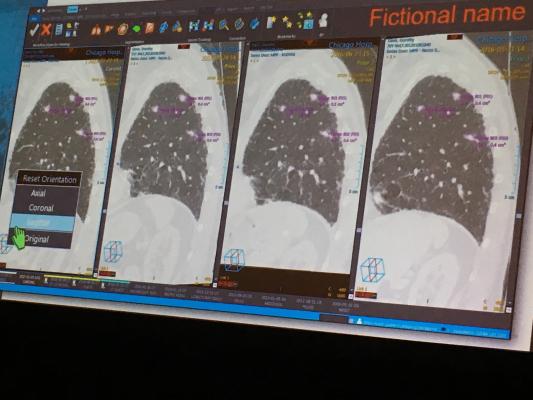
September 18, 2019 — Adding precisely aimed, escalated doses of radiation after patients no longer respond to immunotherapy reinvigorates the immune system in some patients with metastatic non-small-cell lung cancer (NSCLC), increasing progression-free survival (PFS). Findings of the phase II randomized trial were presented at the 61st Annual Meeting of the American Society for Radiation Oncology (ASTRO), Sept. 15-18 in Chicago.1
“This study provides one more important piece of data that indicates that, for some patients, the immune system can be a really powerful tool to combat metastatic lung cancer,” said Allison M. Campbell, M.D., Ph.D., a resident in the Department of Therapeutic Radiology at Yale New Haven Hospital and lead author on the study. “It points us in the direction of places to look for biomarkers that might predict which patients would best respond to this type of therapy."
NSCLC accounts for roughly 80-85 percent of all lung cancers. Approximately 57 percent of patients with NSCLC have already progressed to stage IV cancer at the time of diagnosis, meaning that tumors have spread to other parts of the body, making it difficult to cure. This type of cancer may be treated with radiation therapy, immunotherapy, surgery, chemotherapy or targeted drug therapy to relieve symptoms and allow patients to live longer.
This phase II prospective trial explored the benefits of treating one cancerous lesion with stereotactic body radiotherapy (SBRT) in patients with NSCLC whose cancer had continued to spread after treatment with pembrolizumab, a type of immunotherapy. Campbell and her team looked to see if tumors outside the treated area would also shrink, how long patients lived before their disease progressed after treatment, and what was happening to the immune systems of those patients who responded well to the combination of SBRT and immunotherapy.
The study included 56 patients with NSCLC, all of whom had two or more measurable tumors at enrollment. Of these, six patients had already received immunotherapy and were immediately treated with SBRT, which delivers precise, intense doses of radiation. The other 50 patients had not yet been treated with immunotherapy; of these, 16 were treated with SBRT after their disease progressed after treatment with pembrolizumab (also known by its brand name Keytruda).
A total of 21 patients completed both treatments and lived, on average, five months longer without their disease progressing any further. In two patients (9.5 percent), tumors outside the treated area shrank by 30 percent or more and stayed that way for more than a year. Ten patients (47.6 percent) experienced disease stabilization (tumors neither grew nor shrank) following the addition of SBRT.
“We weren’t surprised to see that some patients had tumors shrink outside the field of radiation,” said Campbell, who added that the research team really wanted to learn more about what was happening in the immune systems of those patients. “There’s been a lot of interest in how radiation can stimulate the immune system. We wanted to learn all we could from our very best responders.”
A closer analysis of the peripheral blood cells in patients whose tumors shrank or did not grow suggested that T cells played an important role in the immune system response, said Campbell. “We found that there were two things that correlated with patients living longer without their disease progressing,” she said. “Those two things were T cells infiltrating the tumor before immunotherapy was given, and the presence of immune-related side effects at any time during the course of treatment, such as inflammation of the lung or inflammation of the GI tract. Patients who experienced these side effects lived a longer period of time before the disease progressed.”
Campbell and her team were able to identify two different types of T cells performing important functions in fighting the tumors. In patients who responded well to the combination therapy, they found both CD8 T cells, which can kill cancer cells directly, and CD4 T cells, which help the immune system organize its response to threats such as cancer. “We saw different proportions of these cells in our good responders versus our bad responders,” she said, “as well as different activation statuses. In people who responded well to the combination therapy, we saw a population of CD8 T cells that looked more excited, and in those with poor responses, we saw a population of CD4 T cells with inhibitory markers. The bigger picture here is that there are signatures in the peripheral blood that are promising avenues for future identification of people who will respond well to SBRT combined with immunotherapy.”
The next step, she said, will be to validate these findings in a larger population.
“We are starting to see that the combination of immunotherapy and radiation is safe, and there are some hints that for certain patients, radiation might be an important option when immunotherapy no longer curbs disease progression,” said Campbell. “Our study lays the groundwork for a phase III randomized trial, which is the gold standard for changing guidelines and clinical practice.”
Read more about clinical trials presented at ASTRO 2019.
For more information: www.astro.org
Reference
1. Campbell A.M., Cai W.L., Burkhardt D., et al. Final Results of a Phase II Prospective Trial Evaluating the Combination of Stereotactic Body Radiotherapy (SBRT) with Concurrent Pembrolizumab in Patients with Metastatic Non-Small Cell Lung Cancer (NSCLC). Red Journal, published online Sept. 1, 2019. https://doi.org/10.1016/j.ijrobp.2019.06.453


 April 25, 2024
April 25, 2024 








